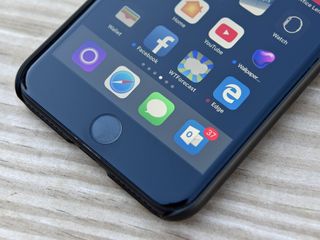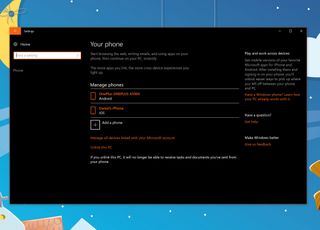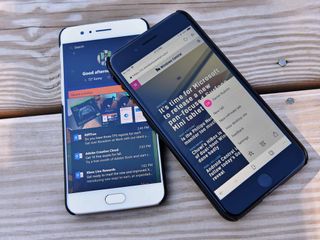The real reason for Edge on iOS and Android is to extend the reach of Windows 10
What powers the Microsoft Edge browser on iOS and Android is irrelevant to its purpose, which is to extend the functionality of Windows 10 to millions of customers.

Earlier in October, Microsoft made a surprise announcement that its Edge browser was headed to iOS and soon after Android. With the browser going open for anyone on Android recently, many users of Windows 10 are downloading – and liking – the experience so far.
In the original announcement, Windows Central clarified that despite the name, underneath the browsers were powered by WebKit for Apple and Chromium on Android. The issue is tangential to the purpose of Edge, yet many tech enthusiasts seem fixated that these are not using the EdgeHTML engine. Here is why it doesn't matter.
Getting into the Store
A primary reason for basing these browsers into the respective Apple and Android app stores is compatibility. Google is more lenient about letting competing products and technologies into its store, but Apple is not. Only browsers built on WebKit follow the guidelines for Apple meaning even if Microsoft made an Edge browser powered by EdgeHTML, it could never get into the store making the venture moot.

For Android, there seems little advantage to investing any Microsoft resources – including engineering and money – into bringing EdgeHTML to the OS. Not only would this delay things indefinitely there is no immediate reason to think it would somehow be better than Chromium.
Microsoft built its Edge browser specifically for Windows 10, including PC, HoloLens, Xbox, Surface Hub, and Mobile. It's tied deeply to the OS and optimized for it. Shoehorning that into a different native environment could be achieved, but the ends don't necessarily justify the means.
Edge is about Windows 10 and services, not the engine
The question I have frequently heard about Microsoft Edge on iOS and Android is why should a phone user even bother? Safari already does quite a lot including "Content Blockers" and deeper integration with macOS.
Likewise, Google's Chrome browser dominates even the PC market with nearly 60 percent usage and according to IDC Android commands 85 percent of the smartphone market, many of which use a default Chromium-based web browser. (Coincidentally, it is on Android where users of Edge get the most benefit since they can set it as the default system browser, something which iOS forbids).
Get the Windows Central Newsletter
All the latest news, reviews, and guides for Windows and Xbox diehards.

But Microsoft Edge on iOS and Android is not necessarily about being better than Safari or Chrome, but about making Windows 10 more useful.
In this age of massive smartphone use, customers prefer browsers that work across the phone and PC. Syncing passwords, tabs, bookmarks, and history is a big deal for many. These features are even more transparent when the barrier to entry is just signing in with your Apple ID or Google account and it just "automagically" happens.
If Microsoft Edge doesn't have an answer to those syncing abilities, its further adoption is unlikely. Asking users to split their browser experiences between two different browsers – one for mobile and one for PC – is a strategy unlikely to win.
In this sense, it's not what powers Microsoft Edge on iOS and Android that matters it's the Windows 10 services it offers, which include:
- Continue on PC: Go anywhere and pick up where you left off by seamlessly moving content between your mobile device and PC (requires Windows 10 Fall Creator's Update).
- Data Sync: Your favorites and reading list are synced across your devices, so no matter the device, your browser is always personalized to you.
Sure, other features like Reading View and Hub View are nice, but it's the ability to extend your Microsoft Edge experience to PC – and vice versa – that gives Microsoft Edge its reason to exist.

Microsoft plans to bring password and tab syncing, eBook reading (for books purchased through the Windows Store), and if I had to guess even Cortana at some point to Edge.
Toss is an optimized browsing experience, clean and minimalist design, and likely some Timeline features coming in Windows 10 "Redstone 4" due in the first half of 2018 and Edge is now a piece of Windows 10 living on millions of smartphones.

The whole mantra behind the Windows 10 experience right now is about making it – and Microsoft's services – as cross-platform compatible as possible to deliver unique and compelling experiences to customers. Microsoft Edge on iOS and Android is a big part of this strategy.
But why bother?
One retort to all of this is: Why should Microsoft bother? People seem locked into their browsers, and it is not evident people will necessarily switch.
But that criticism misses the point. At least with syncing of passwords, browser history, bookmarks, and more available to those on iOS and Android Microsoft has, in effect, eliminated any barriers for users to switch to Microsoft Edge. Whether people leap is another problem related to marketing, mindshare, and in part making Windows 10 itself compelling enough for people to use. That is a concern, but it's at least not a technical reason anymore.

If millions of users say they don't use Microsoft Edge because of "X, " and you eliminate "X," well, that is progress. It's that simple.
Microsoft Edge on iOS and Android is likely the tip of the spear. Bringing features like Timeline, Cortana, cloud clipboard, cloud/A.I.-powered technologies, and broader syncing abilities could make Microsoft Edge a compelling alternative to Chrome for PC. It's this innovation that may eventually differentiate Edge from its competitors. Microsoft Edge being on the world's dominant smartphone platforms is a start.
In other words, don't concern yourself with rendering engines. Look at what Microsoft Edge does and you'll see why it is here.

Daniel Rubino is the Editor-in-chief of Windows Central. He is also the head reviewer, podcast co-host, and analyst. He has been covering Microsoft since 2007, when this site was called WMExperts (and later Windows Phone Central). His interests include Windows, laptops, next-gen computing, and watches. He has been reviewing laptops since 2015 and is particularly fond of 2-in-1 convertibles, ARM processors, new form factors, and thin-and-light PCs. Before all this tech stuff, he worked on a Ph.D. in linguistics, watched people sleep (for medical purposes!), and ran the projectors at movie theaters because it was fun.
